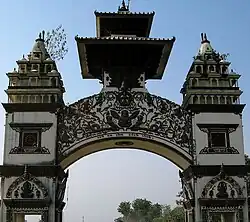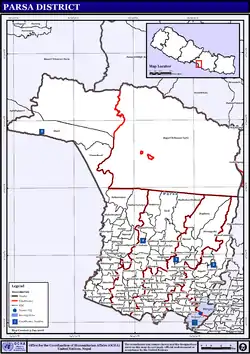Parsa District
Parsa District (Nepali: पर्सा जिल्लाⓘ), a part of Madhesh Province in Terai plain is one of the seventy-seven districts of Nepal. The district, with Birgunj as its district headquarters, covers an area of 1,353 km2 (522 sq mi) and has a population (2001) of 497,219. According to the locals, Parsa is named after Parashnath temple situated in Mahuwan.
Parsa District
पर्सा जिल्ला | |
|---|---|
 The gate in Birganj on the Indo-Nepal border | |
 Location of Parsa District (dark yellow) in Madhesh Province | |
| Country | |
| Province | Madhesh Province |
| Established | During Rana regime |
| Admin HQ. | Birgunj |
| Government | |
| • Type | Coordination committee |
| • Body | DCC, Parsa |
| • Head | Ajay sah sonar |
| • Deputy-Head | puran patel |
| • Parliamentary constituencies | 4 (List) |
| • Provincial constituencies | 8 |
| Area | |
| • Total | 1,353 km2 (522 sq mi) |
| Population (2021) | |
| • Total | 649,397 |
| • Density | 480/km2 (1,200/sq mi) |
| • Households | 95,516 |
| Demographics | |
| • Ethnic groups | Muslim, Kurmi, Tharu, Yadav |
| • Female ♀ | 48% |
| • Male ♂/100 female | 108.21 |
| Human Development Index | |
| • Income per capita (US dollars) | $1657 |
| • Poverty rate | 36.37 |
| • Literacy | 69.1% |
| • Life Expectancy | 70.25 |
| Time zone | UTC+05:45 (NPT) |
| Postal Codes | 44301... 44315 |
| Telephone Code | 051 |
| Main Language(s) | Bhojpuri (78.1%), Nepali (6.4%), Maithili (5.1%), Tharu (3.8%), Urdu (2.2%), others (4.4%) |
| Website | dccparsa |
Etymology
According to locals, the name of the district is derived from the Parsagadhi fort, where the Nepali Gorkhali Soldiers defeated British Soldiers.[3]
Geography and Climate
| Climate Zone[4] | Elevation Range | % of Area |
|---|---|---|
| Lower Tropical | below 300 meters (1,000 ft) | 74.7% |
| Upper Tropical | 300 to 1,000 meters 1,000 to 3,300 ft. |
25.3n% |
Demographics
| Historical population | |||||
|---|---|---|---|---|---|
| Census year | 1981 | 1991 | 2001 | 2011 | 2021 |
| Pop. | 284,338 | 372,524 | 497,219 | 601,017 | 649,397 |
| ±% p.a. | — | +2.74% | +2.93% | +1.91% | +0.78% |
| Source: Citypopulation[5] | |||||
At the time of the 2011 Nepal census, Parsa District had a population of 601,017.
As their first language, 78.4% spoke Bhojpuri, 6.1% Nepali, 5.1% Maithili, 3.8% Tharu, 2.2% Urdu, 1.3% Tamang, 0.8% Rajasthani, 0.7% Newari, 0.3% Uranw/Urau, 0.2% Hindi, 0.2% Rai, 0.1% Bengali, 0.1% Doteli, 0.1% Magar and 0.1% other languages.[6]
Ethnicity/caste: 14.5% were Musalman, 8.4% Kurmi, 7.6% Tharu, 6.6% Yadav, 5.8% Kanu, 4.7% Chamar/Harijan/Ram, 4.2% Teli, 3.2% Koiri/Kushwaha, 2.8% Chhetri, 2.7% Dusadh/Paswan/Pasi, 2.6% Hill Brahmin, 2.6% Mallaha, 2.0% Baraee, 1.9% Kalwar, 1.8% Dhanuk, 1.7% Nuniya, 1.7% Tamang, 1.6% Musahar, 1.6% Newar, 1.6% Sonar, 1.5% Bin, 1.4% Dhobi, 1.4% Hajam/Thakur, 1.4% Kathabaniyan, 1.3% Lohar, 1.3% Tatma/Tatwa, 1.2% other Terai, 1.0% Terai Brahmin, 1.0% Kayastha, 0.9% Marwadi, 0.8% Sanyasi/Dasnami, 0.7% Rajput, 0.6% Kewat, 0.6% Kumal, 0.6% Kumhar, 0.6% Magar, 0.4% Yakkha, 0.3% Dhunia, 0.3% Jhangad/Dhagar, 0.3% Kami, 0.2% Bengali, 0.2% Damai/Dholi, 0.2% Dom, 0.2% Halkhor, 0.2% Kahar, 0.2% Mali, 0.2% Rai, 0.1% Badhaee, 0.1% Gaderi/Bhedihar, 0.1% Gurung, 0.1% Halwai, 0.1% Majhi, 0.1% Natuwa, 0.1% Rajbhar, 0.1% Sarki, 0.1% Thakuri and 0.1% others.[7]
Religion: 83.1% were Hindu, 14.5% Muslim, 1.7% Buddhist, 0.4% Kirati, 0.1% Christian and 0.1% others.[8]
Literacy: 55.7% could read and write, 2.9% could only read and 41.3% could neither read nor write.[9]
Notable people
- Ajay Chaurasiya - Nepali Congress leader, former minister and former Member of House of Representatives/Constituent Assembly
- Ajay Kumar Dwivedi]] - Nepali Congress leader and Member of Constituent Assembly
- Bina Jaiswal - Bina Jaiswal is a Nepalese politician, belonging to the Rastriya Prajatantra Party. She is a member of Parliament currently serving as the member of the 2nd Federal Parliament of Nepal.
- Mohammad Lalbabu Raut Gaddhi - First Chief Minister of Madhesh Province
- Pradeep Yadav - leader of PSP-N and member of House of Representatives
- Arjun shah president Of [ District child club coordination network parsa ] Chief minister of [ Province Mock child parliament]
Administration
VDC/s and Municipalities (blue) in Parsa District The district consists of one metropolitan city, three urban municipalities and ten rural municipalities. These are as follows:
- Birgunj Metropolitan
- Bahudarmai Municipality
- Parsagadhi Municipality
- Pokhariya Municipality
- Bindabasini Rural Municipality
- Dhobini Rural Municipality
- Chhipaharmai Rural Municipality
- Jagarnathpur Rural Municipality
- Jirabhawani Rural Municipality
- Kalikamai Rural Municipality
- Pakaha Mainpur Rural Municipality
- Paterwa Sugauli Rural Municipality
- Sakhuwa Prasauni Rural Municipality
- Thori Rural Municipality
Former Village Development Committees (VDCs) and municipalities

References
- "NepalMap profile: Parsa".
- "Nepal Human Development report 2014".
- "नेपालीले अंग्रेजलाई हराएको पर्सागढी ओझेलमा". Online Khabar. Retrieved 2021-01-02.
- The Map of Potential Vegetation of Nepal - a forestry/agroecological/biodiversity classification system (PDF), Forest & Landscape Development and Environment Series 2-2005 and CFC-TIS Document Series No.110., 2005, ISBN 978-87-7903-210-1, retrieved Nov 22, 2013
- "NEPAL: Administrative Division". www.citypopulation.de.
- NepalMap Language
- NepalMap Caste
- NepalMap Religion
- NepalMap Literacy